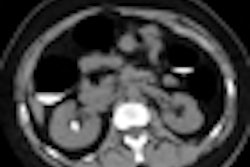Computer-aided detection (CAD) technology can improve the performance of even experienced thoracic radiologists in assessing lung nodules on CT, according to research published in the March issue of Academic Radiology.
In a retrospective study involving 256 lung nodules, a Michigan research team found that all six fellowship-trained thoracic radiologists enjoyed a small but statistically significant increase in accuracy from CAD use. In addition, the group found that recommended changes in action from the use of CAD were mostly helpful.
"These results suggest that CAD may be helpful as a second opinion in increasing diagnostic confidence for radiologists," wrote a research team led by Ted Way, Ph.D., of the University of Michigan in Ann Arbor.
A number of studies with a small group of cases have found that CAD can improve the ability of radiologists to classify lung nodules. Seeking to expand upon those findings, the research team sought to evaluate the technology's effect in a larger dataset with a case mix that included both primary and metastatic lung cancers and a range of CT parameters (Acad Radiol, March 2010, Vol. 17:3, pp. 323-332).
The study group retrospectively selected 124 malignant and 132 benign lung nodules from the thoracic CT scans of 152 patients. All CT studies were acquired using a variety of scanners from GE Healthcare (Chalfont St. Giles, U.K.).
First before and then after the institution's internally developed CAD algorithm was applied, six fellowship-trained thoracic radiologists rated the likelihood of nodule malignancy on a scale of 0% to 100% and recommended appropriate action. The reading order for the nodules was randomized and counterbalanced for each reader, ensuring that no nodule would be read more often in a certain order than other nodules.
The researchers developed a graphical user interface to display the CT scan and record observer ratings. While one nodule was read at a time, the entire CT scan was loaded and slice interval data were provided to the reader, according to the study team. The radiologists knew the total number of nodules and patients in the study, but they were not informed of the proportion of malignant and benign nodules.
The group then applied receiver operator characteristics (ROC) to evaluate CAD's effect. To identify any performance differences with primary cancers and metastatic cancers, the researchers also performed a separate data analysis in a subset of patients with primary cancers and benign nodules and a subset of patients with metastatic cancers and benign nodules. They also examined performance when the eight masses larger than 30 mm were excluded.
The average area under the curve (Az) improved from 0.833 (range, 0.817 to 0.847) to 0.853 (range, 0.834 to 0.887). The difference was statistically significant (p < 0.01).
|
In other findings, radiologists modified their likelihood of malignancy estimates an average of 126 times; of these changes, 95 were considered to be correct, with an increase in malignancy estimate for a malignant nodule and a decrease in malignancy estimate for a benign nodule.
Recommended actions were changed an average of 10.8 times (range, 5-18 times), and correct changes were made an average of 6.8 times (range, 4-10 times). Changes for either benign or malignant nodules were not statistically significant, however.
Statistically significant increases in average Az were also found in the subset of patients with primary cancers (from 0.823 to 0.846) and when excluding masses larger than 30 mm in diameter (0.849 to 0.861). Increases in the subset of patients with metastatic cancers (0.849 to 0.861) were not statistically significant.
"Our results indicate that CAD can benefit radiologists in characterizing lung nodules on CT images," the authors wrote. "The improvement was modest, though significant, possibly because the radiologists participating in the study are experienced fellowship-trained thoracic radiologists."
In future work, the researchers said they would like to expand the dataset to increase the number of training samples, improve the performance of the CAD system, and evaluate the CAD system with a previously unseen dataset.
"Further studies are also needed to determine whether similar improvement in diagnostic accuracy will be realized for radiologists of different experience levels and whether CAD can influence radiologists' patient management decisions and affect patient care in clinical practice," the authors wrote.
By Erik L. Ridley
AuntMinnie.com staff writer
February 17, 2010
Related Reading
Integrating CAD with PACS adds clinical value, December 18, 2009
CT lung CAD helps readers differently, November 4, 2009
Brazilian team marries lung CAD with PACS, August 20, 2009
CARS report: New CAD tool follows lung nodules over time, June 30, 2009
CAD performs well in subsolid pulmonary nodules found with CT, May 15, 2009
Copyright © 2010 AuntMinnie.com





















